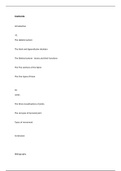Contents
Introduction
P1
The skeletal system
The Axial and Appendicular skeleton
The Skeletal system - bones and their functions
The Five sections of the Spine
The Five types of bone
P2
Joints
The three classifications of joints
The six types of Synovial joint
Types of movement
Conclusion
Bibliography
, Introduction
In this assignment I will be discussing the structure and function of the skeletal system. I will
mention the axial and appendicular and describe the differences between them. I will produce a
labelled skeleton with the correct bone locations and I will discuss the functions of each of these
bones. I will mention and describe the five types of bone and discuss the purpose of each of these. I
will include a labelled spine and describe its structure and the different purposes. I will mention
joints and describe the classifications of joints and their movements. I will discuss the six types of
synovial joint and explain their structure. I will also mention the types of movements available at
each one of these joints.
P1
The skeletal system
There are five main functions of the skeletal system, these include:
· Support – Alongside the muscular system, the skeleton provides support to the body and
keeps the internal organs in place. The strong bones of the spine, pelvis and legs allow
people to stand upright, supporting the weight of the entire body. For example, the skeleton
supports the body in whatever position we take whether it be crouching or standing upright,
the skeleton is crucial for stability and support.
· Protection - The skeleton protects the internal organs from damage by surrounding them
with bone. This is because despite being hard and strong, bone is slightly flexible so it can
resist breakage. For example, when heading a football, the cranium provides protection for
the brain.
· Attachment for skeletal muscle – the bones of the main skeletal system provide a base for
the attachment of muscles. This is why some bones are irregular in shape – to provide a
suitable attachment point for muscles.
· Source of blood cell production – certain bones in the skeletal system contain red bone
marrow which is responsible for the production of red blood cells, platelets and white blood
cells. Some examples of bones that contain red bone marrow and therefore produce red
blood cells include: clavicle, sternum, pelvis and vertebrae. For example, some of the red
blood cells created by the bones carry oxygen to the muscles during exercise.
· Store of minerals – the bones in the skeletal system themselves are made up of minerals.
They act as storage for both phosphorous and calcium which the body uses for muscle
contraction, the maintenance of normal blood pressure and keeping skin healthy.
The Axial and Appendicular skeleton
The skeletal system is divided into main regions: the axial and the appendicular.
Axial skeleton
The axial skeleton is made of the bones that are central on the body, they are along the axis. The
axial skeleton has three main functions: To support, house and protect internal organs and to create





